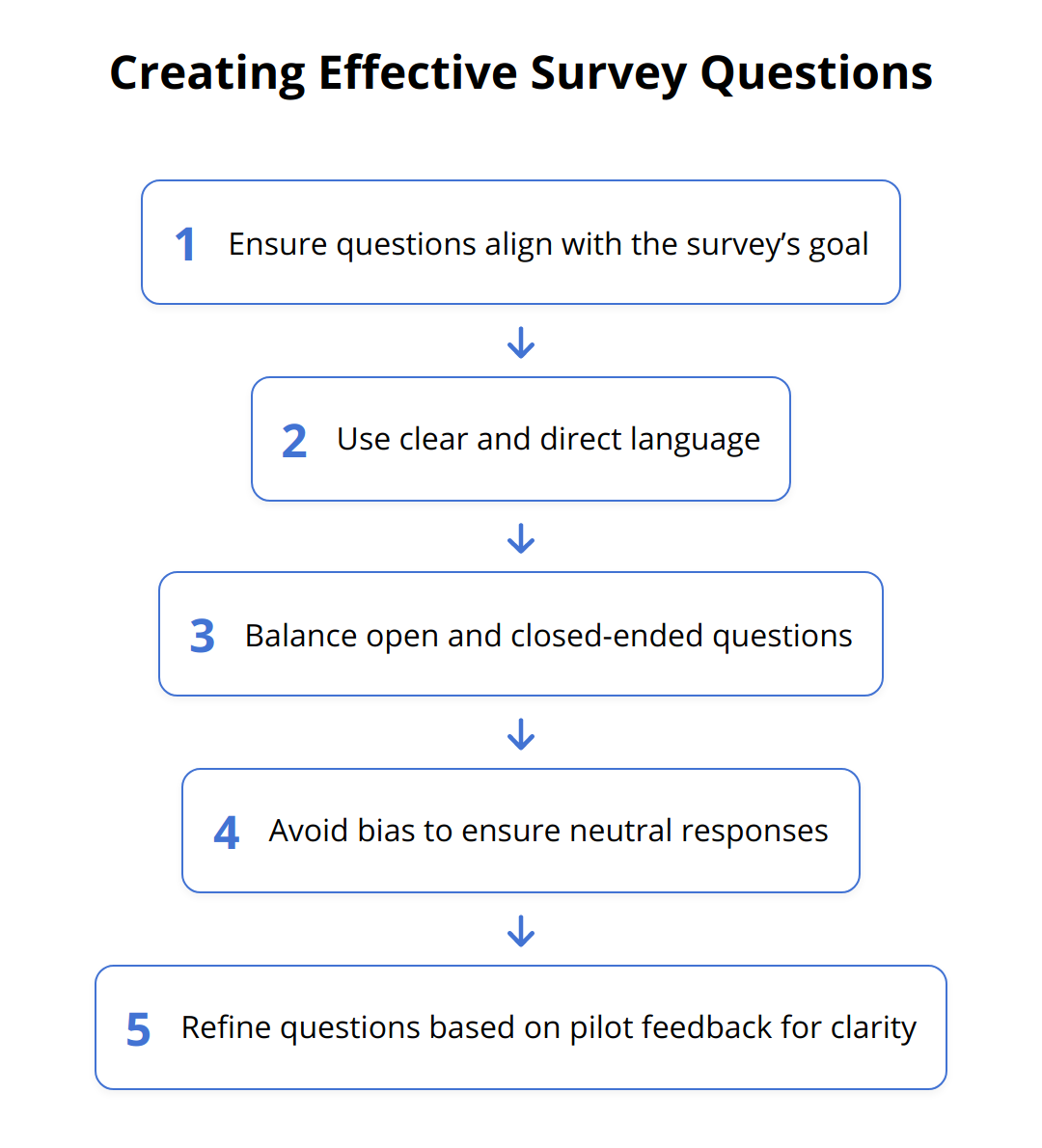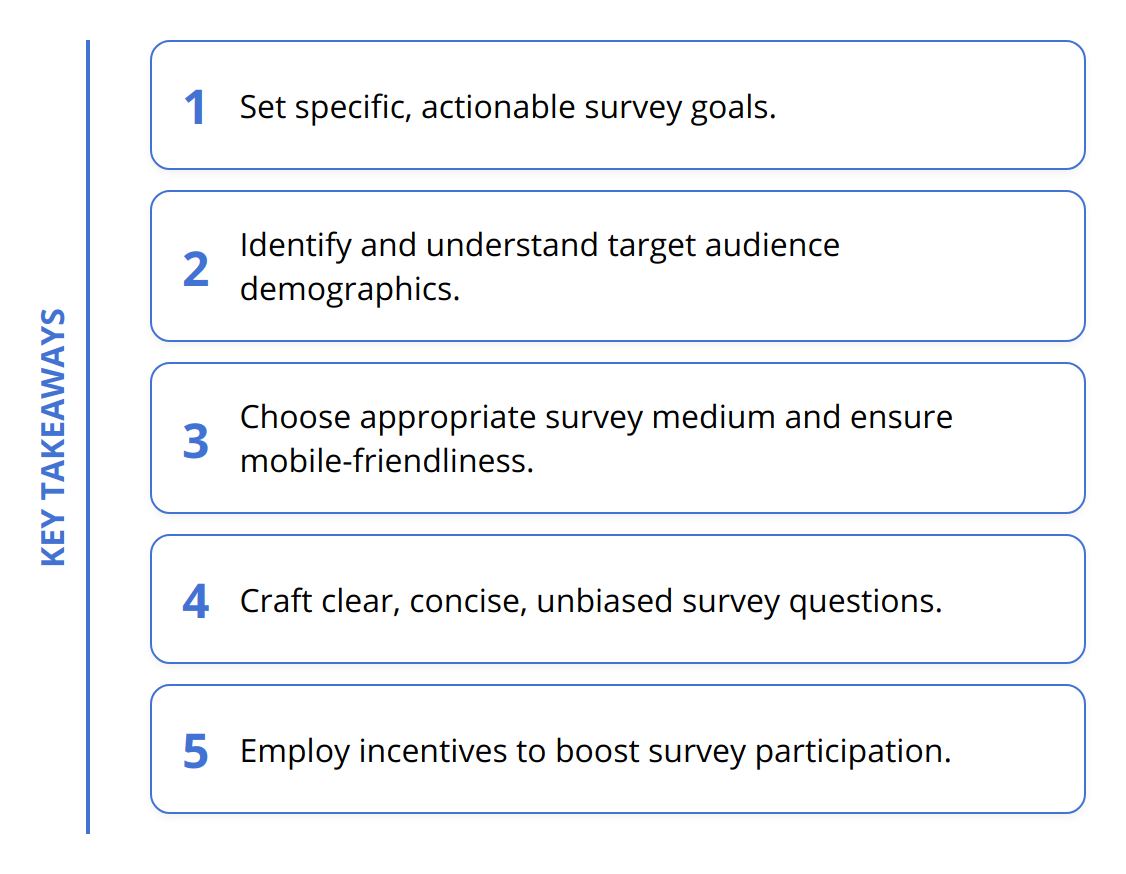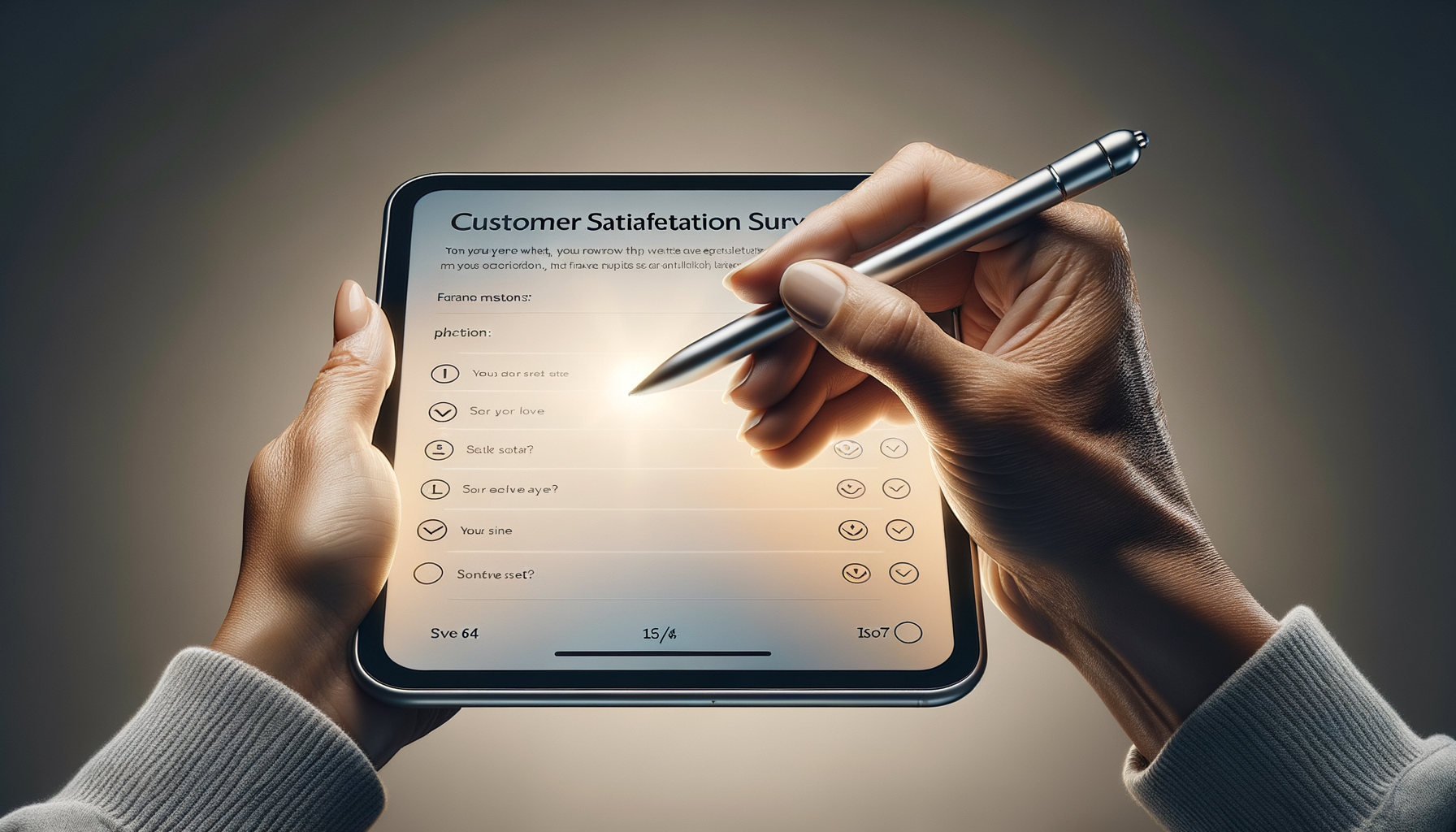Surveys have transformed how businesses understand and serve their customers. Crafting a survey that yields valuable insights starts with sharp focus and strategic question design.
We at Emplibot believe in the power of using the right tools and techniques to tap into customer perceptions efficiently. This guide takes a hands-on approach to help brands better engage with their audience through effective automated customer surveys.
Crafting Your Survey Blueprint
Creating an automated customer survey might seem daunting, but when you break down the process into concrete steps, it’s quite manageable. The key to a successful survey lies in your prep work, where you set the foundations by pinpointing what you aim to achieve, who will provide the insights, and in what format they’ll do so.

Setting Your Sights on Survey Goals
Every survey you create must have a purpose. A clearly defined goal not only steers the direction of your survey but also ensures that every question you ask is relevant and on-point. Maybe you’re aiming to gauge the satisfaction levels of your latest product or determine the effectiveness of your customer support team. Whatever the objective, it should be specific, measurable, and tied directly to an actionable outcome. Remember, a goal without a plan is just a wish.

Knowing Your Audience Inside Out
Your survey isn’t for everyone; it’s for your customers. Identifying your target audience is essential because it helps to tailor your questions. Are you focusing on new users, long-term clients, or a specific demographic? Understanding who they are will dictate not only the language you use but also the channels you’ll choose to distribute your survey.
Here’s a noteworthy point – 89% of consumers want to provide feedback. So, find the segment of your audience that’s most engaged and likely to help you meet your survey goals.
Selecting the Right Survey Medium
With numerous formats available – from quick polls to in-depth questionnaires – choosing the right one can significantly affect your response rates. Emails are fantastic for in-depth surveys, but for quick feedback, in-app or on-site surveys can be more effective.
In this digital age, mobile responsiveness is non-negotiable. About 50% of web traffic comes from mobile devices, so it’s safe to say that if your survey doesn’t play well with smartphones, you’re missing out.

Here are some practical tips to consider when designing your automated customer survey:
-
Align your survey objectives with business goals for a clear focus.
-
Determine the demographic characteristics of your target audience for tailored questions.
-
Pick a survey tool that offers versatility and ease of use – Google Forms and SurveyMonkey are reliable options.
-
Make sure your survey is mobile-friendly to increase completion rates.
Keep these foundations in mind as you construct your survey. They will provide the structural integrity needed to gather the insightful data you’re after. After all, a survey well built is a treasure trove of customer insights waiting to be discovered. With your blueprint ready, you can move forward with crafting questions that resonate and collect the data you need.
Crafting Quality Questions
The heart of your survey lies in the questions you ask. A solid question can be the difference between data you can act on and data that leads nowhere. The best surveys are those where every question has a clear reason for being there and contributes to the overall goal.

Keeping Language Clear and Direct
Everyone appreciates simplicity. When you pack your survey with straightforward questions, you’re more likely to keep respondents engaged. Complex language can confuse and frustrate, causing respondents to abandon the survey or worse, misinterpret the questions. Be direct and use terms familiar to your audience. Making it easy for them is how you get the gold – insightful responses.
The Strategic Use of Question Types
The power of a survey often lies in the mix of question types used. A balance of open-ended and closed-ended questions gives you both the numbers for quick analysis and the nuanced insights that can inform strategic decisions. Closed-ended questions give you the hard data, while open-ended questions offer the why behind the numbers. But always keep these open-ended questions focused; a broad question can lead to a broad spectrum of responses that are hard to quantify.
Overcoming Bias and Leading Questions
One of the worst offenders in survey design is bias. Questions that lead respondents toward a particular answer skew your results and invalidate your data. Write every question from a neutral standpoint. Make sure you’re not suggesting an answer but rather inviting an honest response. Bias-free questions help maintain the integrity of your data.
Here are a few actionable tips to help you craft better survey questions:
-
Use language that’s easy to understand and avoid industry jargon.
-
Make sure questions are short and to the point. Edit ruthlessly.
-
Mix quantitative and qualitative questions to get a full view of the customer experience.
-
Pilot your survey internally to catch confusing wording or biased phrasing.
-
Test your survey across multiple devices to ensure mobile responsiveness.
Remember, the best survey questions are the ones that lead to actionable insights. They’re well-thought-out, clearly worded, and designed to unearth the valuable customer information that can drive your business forward. Keep refining your questions until they’re laser-focused on illuminating the insights you need.
To help further, you might find resources like automated campaigns insightful, providing real-life lessons on how automation can enhance customer engagement, which can further refine your survey techniques.

By adhering to these best practices in crafting your survey questions, you’ll stand a better chance of collecting meaningful, actionable data. And that’s what turns a simple questionnaire into a strategic asset.
Choosing Automation Tools for Surveys
In today’s fast-paced market, the right automation tools can make or break your survey’s success. While you seek to unleash the true potential of customer feedback, selecting the ideal platform becomes paramount. SurveyMonkey, Qualtrics, and Google Forms stand out as frontrunners, yet each serves a unique purpose depending on your business needs and the sophistication of the analysis you’re after.
SurveyMonkey shines for its user-friendly interface and powerful data analysis capabilities. It’s perfect for those who require in-depth insights without getting overwhelmed by complexity. A vast array of question types and customizability options allow brands to create surveys that resonate with their audience. Moreover, SurveyMonkey’s ability to integrate with various apps extends its functionality beyond simple surveys.
Qualtrics, on the other hand, offers a more advanced suite suitable for intricate data collection and analysis. It’s the tool of choice for professionals who need robust survey logic and sophisticated reporting features. However, its complexity may be overkill for smaller operations or those new to customer surveys.
Google Forms is a reliable, no-cost alternative that integrates seamlessly with other Google apps. It’s incredibly useful for businesses starting with automation or those operating with limited budgets. While it may not have the advanced analysis features of its counterparts, its ease of use and direct integration with Google Sheets for data analysis suffices for basic survey needs.
The integration of surveys with Customer Relationship Management (CRM) systems cannot be overstated. It ensures that every piece of customer feedback is captured and associated with the customer profile, enriching data quality and empowering personalized follow-ups. Whether it’s through native integration or API connections, the combination of survey data and CRM systems provides a holistic view of the customer experience.
From a data standpoint, advanced analytics is the ace in your pocket for actionable insights. Raw data from surveys hold little value without the analytical horsepower to make sense of it. Intelligent analytics can reveal patterns, trends, and customer sentiments that would otherwise remain obscured. Tools that offer sentiment analysis, keyword tagging, and trend detection not only save time but also transform feedback into strategic business moves.
To make the best choice for your business, weigh each platform’s features against your goals and resources. If your objective leans towards understanding broad customer sentiments, Qualtrics or SurveyMonkey with their advanced analysis tools might be apt. For straightforward, budget-friendly survey collection, Google Forms is hard to beat. Always consider scalability, as today’s decision should support tomorrow’s growth.
A few practical points to keep in mind:
-
Evaluate your survey needs against each platform’s features, including potential CRM integration.
-
Consider your team’s skill level and resource availability; complex tools may require a steeper learning curve.
-
Analytics capabilities should match your desire for depth of insight – more data isn’t always better if it’s not actionable.
By carefully selecting the right tools and integrating them into your existing systems, you open the door to a wealth of customer insights that can significantly enhance your business decisions. With this foundation, you’re ready to move towards deploying the survey and gathering impactful feedback.
Boosting Survey Participation
The success of an automated customer survey hinges on high participation rates. After all, the more feedback you collect, the clearer the picture of your customers’ needs and preferences. Let’s talk strategy to improve response rates and effectively use the feedback you garner.
Sweetening the Deal with Incentives
People love rewards, and when it comes to surveys, incentives can significantly lift your participation rates. Offering a small discount on future purchases or entry into a prize draw can motivate customers to take the time to share their thoughts. Surveys without incentives tend to have lower engagement rates, and here, data doesn’t lie – offering an incentive can boost response rates by 5 to 20%. Be sure to communicate the reward clearly in your survey invitation to maximize its impact.
Seamless Access Across All Devices
Ignoring the mobile experience is like closing your store on the busiest shopping day. Over 50% of people are now browsing on their phones, and a survey that’s difficult to navigate on a small screen is bound to be ignored. Make your survey easy to complete on any device. Tools like mobile marketing automation can ensure your survey looks great and functions smoothly whether it’s on a desktop, tablet, or smartphone.
Closing the Loop is Key
Feedback is a two-way street. When customers share their time and thoughts, it’s only fair to close the loop. At the very least, a thank you message post-survey completion is a must. But don’t stop there. Follow up with an email detailing the actions you’ve taken based on their feedback. Customers feel valued when they see their input leading to real changes.
Closing the loop can also mean another layer of interaction, such as opening a channel for continued dialogue or offering personalized content down the line. This not only improves customer relations but also encourages them to participate in future surveys.
Now, let’s look at the practical steps to take:
-
Clearly advertise the incentive and make it as enticing as possible within your budget.
-
Test the survey across multiple devices to ensure a smooth experience.
-
Send a follow-up message or email to respondents, summarizing the impact of their responses.
By focusing on the practical elements that encourage survey participation and respectful use of the data provided, you’re on your way to garnering valuable insights that can steer your business in the right direction. The ultimate goal is to collect high-quality feedback from a representative sample of your customer base, and these strategies are vital in achieving just that.
Wrapping Up
Effective surveys are essential for businesses that strive to understand and improve customer experiences. By establishing clear goals, knowing your audience, and asking well-crafted questions, you can not only gather valuable feedback but also show customers that their opinions matter.

Automation in survey creation and distribution can elevate this process, ensuring consistency and efficiency. This can lead to deeper insights and open up opportunities for better customer engagement. The key components that make automated customer surveys effective include:
-
A well-defined purpose guiding the survey design.
-
Questions that are clear, concise, and free of bias.
-
Use of a mix of question types to gather diverse insights.
-
Automation tools that simplify the process and integrate with CRM systems.
-
Strategies to increase participation, such as mobile optimization and incentives.
Continuous improvement driven by customer feedback is vital for growth. By adopting survey automation, you can gather and act on feedback more swiftly, which is imperative in today’s competitive landscape. The insights you collect should inform your strategies and help you fine-tune products, services, and customer experiences.
At Emplibot, we recognize the importance of engaging with customers through every interaction. That’s why we provide a means for businesses to maintain an active, informative, and SEO-friendly blog with minimal effort. Alongside automated customer surveys, using tools like Emplibot can enrich your overall marketing automation strategy, providing fresh content that draws customers in while you gather their feedback to serve them better.
As you continue to refine your customer survey approach, consider embracing technology that streamlines and enhances these interactions. Remember, the true power of surveys lies not just in the questions you ask, but in the actions you take as a result of the answers you receive.
-
Align surveys with your overarching business tactics.
-
Act proactively based on the feedback to improve customer experience.
-
Consider incorporating Emplibot for consistent and automated blog content creation.
By leveraging automated surveys alongside strategic marketing tools, you’re setting your brand up for informed growth and stronger customer relationships. We encourage brands to invest in these technologies to not only understand but truly connect with their audience. The future of customer engagement is automation, and with the right tools, your business can relentlessly innovate and excel.

